|
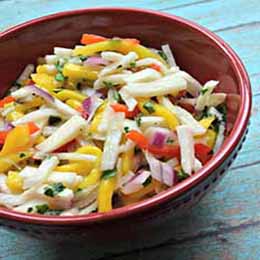
[1] Jicama pairs with savora and sweet ingredients. Here’s the recipe for this salad, which adds sweet mango (photo © All Recipes).
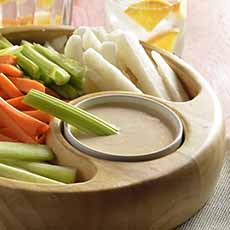
[2] Jicama and other crudités with chipotle dressing. Here’s the recipe (photo © Kiwilimón).
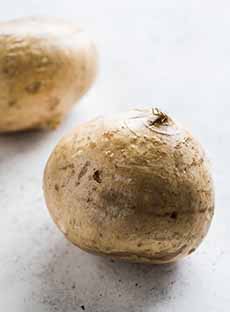
[3] Jicama can be eaten raw or cooked (photo © Isabel Eats).
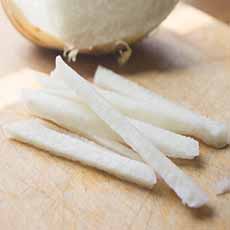
[4] The firm flesh can be sliced and diced in any fashion (photo CCO Public Domain).
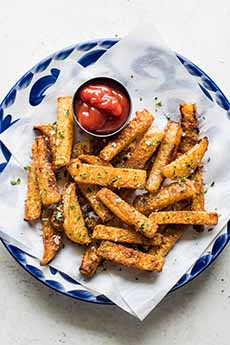
[5] Baked jicama fries. Here’s the recipe (photo © Isabel Eats).
|
|
Jícama, native to Mexico and Central America, is one of the more under-used vegetables in the U.S. Why not make Cinco de Mayo an occasion to try it, with the jícama salad recipe below.
Like other root vegetables, jícama is no beauty at first glance (photo #3). But slice it open to reveal glistening white flesh (photo #4), which is mild with a slight sweetness and the crisp crunch of a water chestnut.
Its subtle flavor enables it to pair with just about any ingredient with savory or sweet condiments.
Jicama spread from Central America to South America, and has been found at archaeological sites in Peru dating to 3000 B.C.E. [source].
In the 17th century, the jicama vine was introduced to Asia by the Spanish, and it is now found in popular Asian recipes.
> The jicama salad recipe is below.
> More Cinco de Mayo recipes.
WAYS TO USE JICAMA
Once you’ve peeled a jícama, what do you do with it?
Raw. Enjoy it as a snack like carrots or celery—plain, with salsa or another dip, or on a crudités plate. Turn it into a high-fiber, protein snack with bean dip.
A classic Mexican preparation is to thinly slice jicama, then sprinkle with lime juice, chili powder, and salt. You can use any other seasonings instead.
You can even make jicama pickles (here’s how), or make or buy jicama kimchi.
Salad. Toss with your favorite ingredients—avocado, carrots, edamame, fennel, jalapeño, onion, mushrooms, etc. Add it to coleslaw along with the cabbage.
Make a luncheon salad by adding chicken, seafood, or tofu. Prepare an easy dressing of olive oil, lime juice, and cilantro, with a pinch of salt.
Add to egg salad, tuna/seafood salad, etc., for crunch. Ditto with a fruit salad.
Cooked. Jícama can be baked, boiled, fried, sautéed or steamed. As long as you don’t overcook it, jícama retains its pleasantly crisp texture (think raw apple) when cooked. Add it to soups and stir frys.
Deep fry or bake jicama fries instead of potatoes (photo #5). Here’s the recipe
JICAMA NUTRITION
Only 27 calories per cup.
An excellent source of vitamin C and potassium, with good amounts of B6, iron and magnesium.
Prebiotic fiber supports healthy digestion and gut microbiome diversity.
An excellent source of oligofructose inulin, a soluble dietary fiber*.
RECIPE: JICAMA SALAD
Thanks to Melissa’s Produce for the recipe.
Ingredients
1 pound jicama
8 ounces red onion
8 ounces cucumbers (ideally kirby or other seedless)
2 tablespoons cilantro
Juiuce of 5 limes, freshly squeezed
2 tablespoons olive oil
2 oranges segmented, or 6 tangerines
1 teaspoon pico de gallo seasoning†
Preparation
1. PEEL the jicama, onion, and cucumber. Dice into medium-sized pieces.
2. RINSE and chop the cilantro.
3. COMBINE the lime juice, olive oil, and pico de gallo. Combine in a bowl with the rest of the ingredients and let marinate for 30 minutes. Adjust the seasoning and serve.
________________
*Inulin is a zero-calorie, sweet, inert carbohydrate and does not metabolize in the human body.
†You can buy pico de gallo seasoning or make your own. Combine 3 tablespoons sweet paprika, 2 tablespoons ground red chili pepper, 1 tablespoon cayenne pepper powder, 1 tablespoon black pepper, and 1 tablespoon salt. Use immediately or place it in an airtight jar for future use.
|







